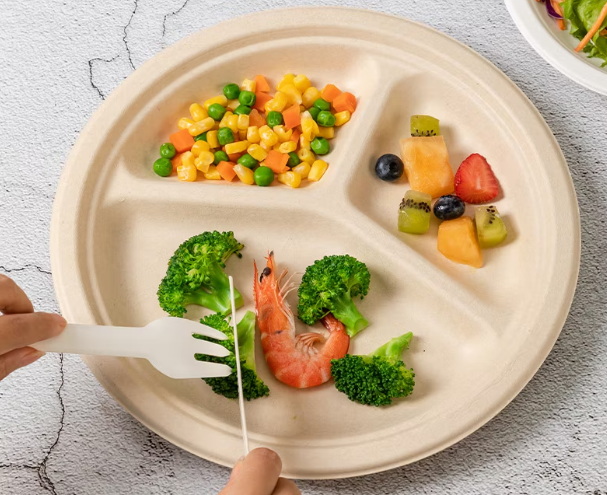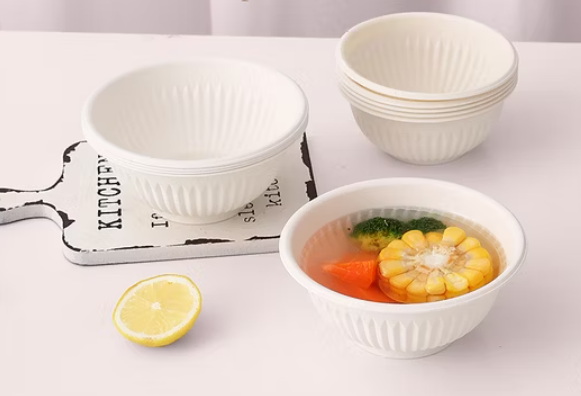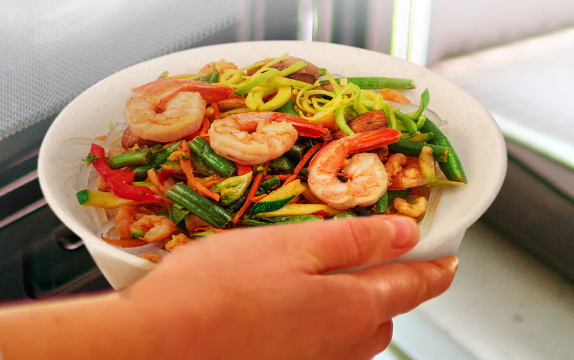
Content Menu
● Introduction to Disposable Hot Food Shallow Bowl Plates
>> Types of Materials Used
● Wholesale Disposable Hot Food Shallow Bowl Plates
>> Advantages of Wholesale Purchasing
>> How to Choose Microwave-Safe Bowls
● Safety Considerations
>> Health Risks
>> Environmental Impact
● Environmental Considerations
>> Sustainable Alternatives
● Practical Tips for Microwave Use
● The Role of Wholesale Suppliers
● Consumer Awareness
● Conclusion
● Frequently Asked Questions
>> 1. What types of materials are safe for microwave use?
>> 2. How do I know if a bowl is microwave-safe?
>> 3. Are all wholesale disposable bowls suitable for hot foods?
>> 4. What are the environmental benefits of using plant-based bowls?
>> 5. Can I reuse wholesale disposable hot food shallow bowl plates?
● Citations:
In recent years, the use of disposable hot food shallow bowl plates has become increasingly popular due to their convenience and eco-friendliness. These plates are often used for serving hot foods like soups, stews, and curries, but the question remains: are they safe for microwave use? In this article, we will delve into the safety aspects of using wholesale disposable hot food shallow bowl plates in the microwave, exploring different types of materials and their microwave compatibility.

Introduction to Disposable Hot Food Shallow Bowl Plates
Disposable hot food shallow bowl plates are designed to be convenient and easy to use, especially in settings like parties, events, or takeout services. They come in various materials, including paper, plastic, and plant-based fibers. The choice of material significantly affects their microwave safety.
Types of Materials Used
1. Paper Bowls: These are often made from paperboard and can be microwave-safe if they are uncoated and specifically labeled as such. However, those with wax or plastic coatings are not suitable for microwave use as they can melt or release harmful chemicals into food.
2. Plastic Bowls: Plastic bowls, especially those made from polypropylene (PP), are generally microwave-safe. However, it's crucial to ensure they are BPA-free to prevent toxin migration into food.
3. Plant-Based Bowls: These bowls are made from materials like sugarcane fiber or palm leaves. They are biodegradable and often microwave-safe, offering an eco-friendly alternative to traditional plastic bowls.
Wholesale Disposable Hot Food Shallow Bowl Plates
Wholesale disposable hot food shallow bowl plates are a cost-effective option for businesses and individuals looking to serve hot foods efficiently. When purchasing in bulk, it's essential to consider the material and microwave safety of the bowls.
Advantages of Wholesale Purchasing
- Cost-Effective: Buying in bulk reduces the cost per unit, making it more economical for large events or businesses.
- Variety of Options: Wholesale suppliers often offer a range of materials and designs, allowing you to choose the best fit for your needs.
- Convenience: Bulk purchasing simplifies inventory management and ensures you always have enough bowls on hand.
How to Choose Microwave-Safe Bowls
When selecting wholesale disposable hot food shallow bowl plates for microwave use, follow these guidelines:
1. Check for Labels: Look for "microwave-safe" labels or symbols on the packaging or the bowls themselves.
2. Material Selection: Opt for uncoated paper or BPA-free plastic bowls. Avoid bowls with wax or plastic coatings that can melt or release toxins.
3. Test the Bowls: If unsure, perform a simple test by heating a bowl with a cup of water in the microwave. If the bowl remains cool while the water heats up, it's likely microwave-safe.

Safety Considerations
Health Risks
Using non-microwave-safe bowls can lead to health risks, including the ingestion of harmful chemicals or particles from the bowl material. Always ensure that the bowls you use are specifically designed for microwave heating. For instance, certain plastics can melt or warp when exposed to microwave heat, potentially releasing harmful chemicals like BPA or phthalates into your food[1].
Environmental Impact
While disposable bowls are convenient, their environmental impact should not be overlooked. The production of disposable paper bowls, for example, emits greenhouse gases and contributes to climate change[2]. Opting for eco-friendly materials like plant-based fibers or recyclable paper can help reduce waste and support sustainability efforts.
Environmental Considerations
The environmental impact of disposable bowls is a significant concern. Traditional plastic bowls are non-biodegradable and contribute to plastic waste, which poses a substantial challenge for ecosystems[6]. In contrast, eco-friendly bowls made from materials like sugarcane or palm leaves are biodegradable and compostable, offering a more sustainable option.
Sustainable Alternatives
1. Plant-Based Bowls: These bowls are not only microwave-safe but also biodegradable, reducing the environmental footprint compared to traditional plastic bowls.
2. Recyclable Paper Bowls: While paper bowls have their environmental drawbacks, opting for recyclable options can help mitigate waste issues.
3. Reusable Bowls: Although not disposable, reusable bowls made from materials like ceramic or glass are a sustainable alternative for frequent use.
Practical Tips for Microwave Use
When using disposable bowls in the microwave, follow these practical tips to ensure safety and efficiency:
1. Avoid Metallic Elements: Never use bowls with metallic decorations or components in the microwave, as they can cause sparks or fires.
2. Limit Heating Time: Avoid overheating by limiting microwave time. For paper bowls, it's generally recommended not to exceed five minutes[3].
3. Monitor the Microwave: Always stay near the microwave when heating food in disposable bowls to quickly respond if any issues arise.
4. Choose the Right Material: Ensure that the bowl is made from a material suitable for microwave use, such as uncoated paper or BPA-free plastic.
The Role of Wholesale Suppliers
Wholesale suppliers play a crucial role in providing microwave-safe disposable bowls. They often offer a variety of materials and designs, allowing consumers to choose options that are both safe and environmentally friendly. When purchasing from wholesale suppliers, it's essential to inquire about the microwave safety of their products and to look for certifications or labels that indicate compliance with safety standards.
Consumer Awareness
Consumer awareness is key to ensuring the safe use of disposable bowls in microwaves. By understanding the risks associated with non-microwave-safe materials and choosing eco-friendly options, consumers can contribute to a safer and more sustainable dining experience.
Conclusion
In conclusion, wholesale disposable hot food shallow bowl plates can be safe for microwave use if they are made from the right materials and are specifically labeled as microwave-safe. It's crucial to choose bowls that are designed for microwave heating to avoid health risks and ensure a safe dining experience.

Frequently Asked Questions
1. What types of materials are safe for microwave use?
Answer: Uncoated paper, BPA-free plastic, and plant-based materials are generally safe for microwave use. Avoid materials with wax or plastic coatings.
2. How do I know if a bowl is microwave-safe?
Answer: Look for "microwave-safe" labels or symbols on the packaging or the bowl itself. You can also perform a simple test by heating the bowl with a cup of water in the microwave.
3. Are all wholesale disposable bowls suitable for hot foods?
Answer: Not all disposable bowls are suitable for hot foods. Ensure that the bowls you choose are designed for serving hot foods and are microwave-safe if needed.
4. What are the environmental benefits of using plant-based bowls?
Answer: Plant-based bowls are biodegradable and compostable, reducing waste and supporting sustainability efforts compared to traditional plastic bowls.
5. Can I reuse wholesale disposable hot food shallow bowl plates?
Answer: While designed for single use, some durable bowls can be gently washed and reused. However, this is not recommended for all types of bowls, especially those with coatings.
Citations:
[1] https://www.sumkoka.com/are-disposable-takeout-containers-microwavable.html
[2] https://www.sowinpak.com/news_details/The_environmental_impact_of_disposable_paper_bowls.html
[3] https://diyecobox.com/microwaving-paper-bowls-safety-tips-guidelines-2/
[4] https://www.bioleaderpack.com/can-you-put-disposable-paper-plates-and-dishes-in-the-microwave-or-oven/
[5] https://www.bbc.com/future/article/20200714-is-it-safe-to-microwave-food
[6] https://emeraldecovations.com/2024/09/the-convenience-and-sustainability-of-disposable-bowls/
[7] https://smartyhadaparty.com/blogs/home/how-to-tell-if-a-plastic-plate-is-safe-for-microwaves
[8] https://digg.com/2017/microwaving-plastic
[9] https://www.hotpackwebstore.com/blogs/hotpack-blogs/the-environmental-impact-of-disposable-cups-and-how-suppliers-can-help
[10] https://www.sowinpak.com/news_details/Microwave_Safe_Paper_Bowls
[11] https://smartyhadaparty.com/blogs/home/can-you-microwave-paper-bowls
[12] https://ai-care.id/lifestyle/risks-of-heating-food-in-plastic-containers-en
[13] https://purpleclay.com/blogs/news/eco-friendly-disposable-bowls-a-step-towards-sustainable-living
[14] https://gmz.ltd/can-you-put-paper-cups-in-the-microwave/
[15] https://www.landersappliance.com/microwaves-technical-safety-tips/

















